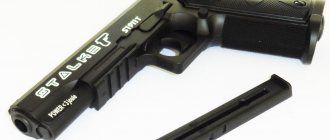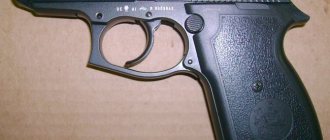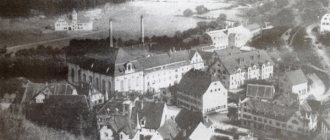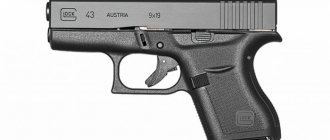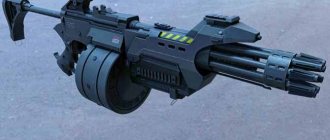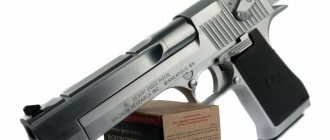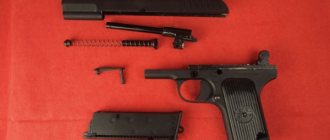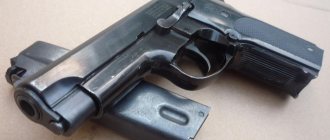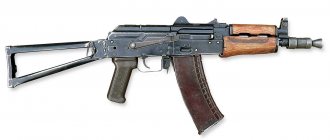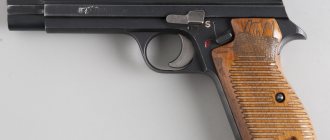| Makarov pistol modernized PMM | |
| Type | self-loading pistol |
| A country | Russia |
| Service history | |
| Years of use | 1994 — |
| Adopted | 1994 |
| In service | Ministry of Internal Affairs of Russia |
| Production history | |
| Constructor | B. M. Pletsky R. G. Shigapov P. Ivshin |
| Designed by | early 1990s |
| Manufacturer | Izhevsk Mechanical Plant |
| Years of production | 1994 — |
| Characteristics | |
| Weight, kg | 0.76 (unloaded) 0.88 (loaded) |
| Length, mm | 165 |
| Width, mm | 34 |
| Height, mm | 127 |
| Cartridge | 9×18 mm PM |
| Caliber, mm | 9 |
| Rate of fire, rounds/min | 30—35 |
| Initial bullet speed, m/s | 315 (9×18 mm PM) |
| Sighting range, m | 50 |
| Type of ammunition | 12-round box magazine |
The 9-mm Makarov pistol, modernized PMM
(GRAU Index - 56-A-125M) is a Russian pistol developed at the Izhevsk Mechanical Plant design bureau in the early 1990s as part of the Grach R&D theme. He took part in a competition for a new army pistol under the designation “Rook-3”[1].
Description
70% of the PMM pistol parts are interchangeable with the pistol [2].
The pistol has a reinforced frame and increased bolt weight. The PMM chamber is equipped with spiral grooves, which allows the use of high-impulse 9x18 mm PMM cartridges for firing. When fired, the pressure of the powder gases presses the walls of the case into three grooves on the walls of the chamber, holding the case in the chamber until the bullet leaves the barrel and the pressure decreases, after which the case is extracted and ejected. The maximum pressure in the gun barrel with the new cartridge increased by 15%, which slightly increased recoil.
The magazine cover protrudes slightly forward, which gives support to the palm and can somewhat speed up reloading. The shape of the handle has been changed to a more comfortable one, which has improved the conditions for aiming and shooting offhand from the right hand. The rear end of the handle has a notch for a more secure hold. Changing the retention devices can significantly improve pistol shooting accuracy.
Sights are open type - front sight and rear sight with a slot.
Design flaws
Springs in magazines work under overstress, so they quickly lose their elasticity, which leads to delays when shooting. Poor quality plastic material from which the feeder is made can cause cracks and cause wear or breakage of the feeder tooth.[3]
Dishwasher PMM F1
The PMM F-1 front-loading dishwasher is designed for highly efficient washing of dishes and cutlery using detergents and rinsing agents in catering establishments. First used in the design of domestic RADA front-facing dishwashers, the two-chamber boiler technology not only ensures the highest standard of hygiene, but also does not require additional consumption of detergents and electricity. RADA dishwashing equipment will satisfy the most demanding and demanding customer.
Model features:
- PMM-F1 - Basic configuration. Equipped with a rinse aid dispenser.
The main advantages of the PMM F-1 dishwasher:
- High-quality steel: the machine body is made of AISI 304 stainless steel with a high nickel content, which gives the material high corrosion resistance and durability.
- Accessories. The model uses Italian components, which guarantees high quality and reliability during operation of the machine.
- Ease of use: Micro safety sensor stops the work cycle if the door is accidentally opened; The rinse aid dispenser saves time when starting the machine; The dishwasher stand ensures ergonomic operation when loading and unloading dishes; Simple control panel.
- Economical: low energy consumption makes the machine profitable to use; the technical solution of the boiler design allows you to heat running cold water to a temperature of 85°C in a short period of time.
- Guaranteed safety: the door fastening does not allow water to splash out of the machine during the washing process; heating of the front surfaces no more than 55°C (according to GOST, the safe heating level is 75°C)
Specifications
| Name | PMM F-1 |
| Productivity (plates/hour): | 270-540 |
| Rated AC Voltage (V): | 220 V, 50 Hz |
| Main program cycle time (s): | 120 |
| Rinse water temperature (degrees): | 85 |
| Washing temperature (degrees): | 55 |
| Overall dimensions, mm): | 626 x 594 x 857 |
| Weight (kg): | 65 |
| Water pressure at the supply water pipe (atm): | no less than 2, no more than 4 |
| Diameter of pipes for connection to the sewerage system (mm): | 32 |
| Pipe diameter for connecting to the water supply: | 3/4 » |
| Boiler volume (l): | 6 |
| Bath volume with cleaning solution (l): | 32 |
| Basket size (mm): | 500x500 |
Models and prices
| Name | Dimensions, mm | Equipment and tech. characteristics | price, rub. |
| Dishwasher PMM F1 | 626x594x837 | 3.75 kW, 220V, 270-540 tare/hour. Basket size 500x500 mm. Set - basket for plates, basket for glasses, basket for cutlery. Bath volume 32 l. Boiler volume 6 l. Temp. wash 55°C. Temp. rinse 85°C. Duration washing cycle 120s. Rinse aid dispenser. Stainless steel AISI-304 steel. | 50490 |
| Dishwasher PMM F1 D | 3.75 kW, 220V, 270-540 tare/hour. Basket size 500x500 mm. Set - basket for plates, basket for glasses, basket for cutlery. Bath volume 32 l. Boiler volume 6 l. Temp. wash 55°C. Temp. rinse 85°C. Duration washing cycle 120s. Rinse aid dispenser, detergent dispenser. Stainless steel AISI-304 steel. | 52074 |
Options and modifications
- PMM-8
- a model chambered for the 9x18 mm PMM cartridge with an 8-round magazine identical to the PM magazine; - PMM-12
- a model chambered for the 9×18 mm PMM cartridge with a double-row magazine for 12 rounds, turning into a single-row neck; - IZH-70-100 (IZH-70-17A)
is a sports pistol, model 1994, chambered for the 9×18 mm PM cartridge, has a magazine for 12 rounds and the appearance of a PMM pistol (differs in an adjustable sight)[4]. - “Baikal-442”
is an export modification chambered for the 9×18 mm PM cartridge, a sports pistol. In September 2020, it was certified for sale in Russia as a sports training pistol[5] - IZH-71-100
(since September 2008, produced under the name
MP-71N
) - a service modification chambered for the 9x17 mm K cartridge, magazine capacity 10 rounds.
Operating principle of PM
The trigger mechanism is based on the principle of double action, when after installing a magazine with cartridges, the trigger is pressed with force, then the hammer is cocked and the sear is released, and hits the firing pin. A shot occurs. After the shot, the housing cover begins to move back, overcoming the force of the recoil spring.
Once the cover has reached its rearmost position, the ejector pin on the slip stop slides out at the left rear of the empty housing. The ejector tooth pushes the housing out of the ejection port. The bolt begins to move forward, removing the next cartridge from the magazine, pushing it into the chamber, thereby self-loading the pistol.
Finally, the bolt slides into the battery (all the way forward), the prong lifts off the rim of the chuck and snaps into place. The pistol is now ready to fire again. The disconnector prevents a second shot from being fired by the same trigger pull.
Subsequent shots are single action, meaning that the hammer is already cocked and that the action of the trigger pushes the sear away from the hammer, thereby releasing the hammer.
The hammer is floating, without a return spring. This is a very simple mechanism that has been working for over 50 years. The other side of the hammer interacts with the sear to stop it at the bottom of its movement if the side of the hammer is damaged. This ensures that the gun will not fire unless the trigger is pulled.
After the last shot is fired, the repeater tab on the magazine pushes up to release the cover, and it is locked in the rear position. The magazine should now be removed and a new one inserted.
By pressing the trigger, the recoil spring pushes the slide forward, removing the first round of the magazine into the chamber, and the pistol is ready to fire in single action mode.
The safety can be easily removed by turning it clockwise past the "safe" position, turning it away from the muzzle at an angle of approximately 120°, and pulling it out. The safety also holds the firing pin in place, so care must be taken to ensure that the firing pin is not lost when the safety is removed.
The magazine consists of 4 main parts: body, spring, pusher and plate. Its capacity is 8 rounds of 9×18 mm PM caliber. Magazines can get dirty, so they need to be cleaned periodically.
The magazine release button is located on the bottom of the pistol, near the bottom of the grip. To release the magazine, press the magazine release button down until the magazine drops slightly. You can take out the magazine.
The barrel is secured in a frame, and a pin ensures its return. The barrel can be replaced with a different caliber or configuration.
Some Soviet (Russian) pistol models come with an adjustable rear sight, but the original Makarov has a fixed rear sight. Even though it's called "fixed," it can be moved left or right with a gentle push.
The Makarov consists of only 27 parts, which is significantly less than the Walter, who has 42. The simplicity of the pistol's design is a very ingenious invention of Makarov and allows the pistol to be disassembled with a small number of tools. Some parts are multifunctional. For example, the hammer spring also serves as a magazine release, the safety holds the firing pin in place, and the trigger mechanism also acts as an ejector. Below is a cheat sheet for performance characteristics of pm 9mm, which is especially relevant for cadets of military schools.
Notes
- Sergey Monetchikov. Arsenal: “Three heroes”, or new combat pistols // “Brother” magazine, January 2009
- A. B. Zhuk. Encyclopedia of small arms: revolvers, pistols, rifles, submachine guns, machine guns. - M.: Voenizdat, 2002. pp. 436, 439
- Domestic pistols: personal opinion of a specialist | Army Herald
- Pistols IZH-70, IZH-71 // A. I. Blagovestov. What they shoot from in the CIS: Directory of small arms. / edited by A.E. Taras. Minsk, “Harvest”, 2000. pp.57-60
- Sports pistols "Baikal-442"
- "Makarov" will be sent to warehouses, 06/07/2016 Vladimir Vashchenko, Ekaterina Zgirovskaya. "Gazeta.Ru".
- “ personal weapons - PMM pistols
” Diana Tyurina. Anti-terror group // magazine “Master Gun”, No. 5-6, 1996. pp. 63-68 - « 1.2.
9 mm pistols PM (56-A-125), PMM (56-A-125M) "Order of the Ministry of Internal Affairs of the Russian Federation No. 173 of February 17, 2001 "On approval of lists of special means, types, types and models of firearms and gas weapons , cartridges for it, standards for providing them to employees of paramilitary and private security guard units under internal affairs bodies" (as amended by Order of the Ministry of Internal Affairs of the Russian Federation No. 651 of 07/09/2002) - Resolution No. 776 of October 2, 2009 “On the provision of combat hand-held small arms and other weapons, ammunition for them, special means, equipment and supplies to the Federal Bailiff Service”
- Decree of the Government of the Russian Federation No. 718 of December 5, 2005 “On awarding weapons to citizens of the Russian Federation”
Ammunition used in PM
Before telling what ammunition was used in the PM, it is necessary to briefly outline the history of the appearance of the standard 9x18 cartridge.
The development of a new 9 mm cartridge began at Experimental Design Bureau No. 44, which was headed by B.V. Semin. The shell from a standard cartridge (7.62×25) was taken as the basis. As a result of test shooting ranges, a decision was made to reduce the length to 18 mm.
In 1947, development tests of new cartridges were carried out, noted in the documents as OP-1 cartridges. The tested cartridges were compared with TT pistol cartridges, as well as with German 9x19 (Parabellum). As a result, after eliminating all the comments and shortcomings, the 9x18 mm cartridge was adopted for service in 1951.
In the 60s of the 20th century, bullets with increased impact and armor-piercing characteristics were developed for KGB officers. However, more accurate information about the bullets used and the performance characteristics of the Makarov pistol in this modification is not publicly available.
In the 90s, attempts were made to use cartridges with increased penetration in the PM. The results of such an experiment did not find support among military experts, especially since work on 9x19 mm and 9x21 mm cartridges had already been developed and was underway.
Air gun
Air pistols have become widespread both for sporting purposes and for leisure by the general population. The variety of this type of weapon is such that it will satisfy any requirements and preferences of shooting sports enthusiasts.
The MP 654k PMM air pistol structurally reproduces the PM combat model. This model is made entirely of weapon grade steel. The barrel is rifled, its length is 9.6 cm. The frame of the pistol is made slightly weakened, unlike the combat PM. But the bolt is retracted and placed on the bolt stop in the same way as in its firearms counterpart.
The pneumatic gun retained almost the same weight and dimensions as the combat one:
- Weight – 730 grams.
- Total length – 16.9 cm.
- Height -14.5 cm.
- Width – 3.5 cm.
In the pneumatic handle, instead of a cartridge clip, a can of compressed gas with a volume of 8 or 12 grams is installed. It also contains a valve and a cassette for 13 spherical bullets, which can be either copper-plated or steel.
Links
Airborne PVD-20 • DPP-40 Rear SP-19 • NARM • NZhM-56 • MLZh-M Means of motorization of crossings Towing and motor boats NKL-27 • SMK-75 • BMK-70 • BMK-90 • BMK-90M • BMK-130 • BMK-130M • BMK-130ML • BMK-150 • BMK-150M • BMK-150M1 • BMK-T • BMK- 225 • BMK-460 Motor links MZ-235 • MZ-330 Outboard motors SZ-10 • SZ-20 • MV-72 • MV-180 • SZM-45 Self-propelled landing craft Self-propelled ferries GSP • PMM • PMM-2 • PMM-2M • PDP Conveyors MAV • BAV • K-61 • PTS • PTS-M • PTS-2 • PTS-3 • PTS-4 Landing boats Iolshin's boat • Iolshin's bag • PMK • MIK-39 • A-3 • LG-12 • LMN • DSL • MSL • SDL • • MPK • DL-10 • NDL-10 • NDL-20 • NL-5 • NL-8 • NL-15 • NL-30 • SNL-8 Mechanized bridges Tank bridge layers MTU • MTU-20 • MT-55 • MTU-72 • MTU-90 Automobile bridge layers KMM • TMM • TMM-3 • TMM-3M • TMM-3M1 • TMM-6 Collapsible bridges Small spans MARM • TARM • MMP Medium and large spans SARM • BARM • TRM • MPB • GARM • RMM-4 • MVB Bridge construction means Combined arms KMS • KMS-E • USM • USM-2 • USM-3 Rear PSK-2-500 • SMP-86 • UZS • USB
